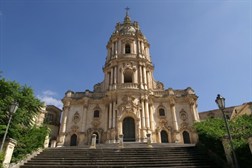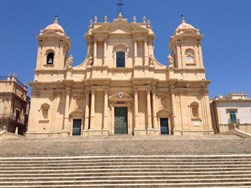The cathedrals of Modica and Noto
Modica, a town in the province of Ragusa, was included, along with the entire Val di Noto, in the list of UNESCO World Heritage Sites, especially in consideration of its historical center and the beautiful Baroque architecture that distinguishes it from the reconstruction after the earthquake of 1693.
 The Cathedral of San Giorgio (Saint George), considered one of the symbols of the Baroque of south-eastern Europe, stands today as the result of the reconstruction which the original structure underwent, dating from the twelfth century, as a result of the earthquakes of 1542, 1613 and especially 1693 (although other earthquakes during the eighteenth and nineteenth centuries also damaged the structure). Various artists and architects took part in the renovation of the complex. The imposing façade of a tower was built from 1702 onwards and completed in the next century. It reaches a total height of 62 metres, while the dome is 36 metres high. A spectacular staircase consisting of 164 steps leads to the five portals, which introduce the five naves inside. On either side of the staircase, a roof garden on several levels, the Orto del Piombo, contributes to the monumentality of the temple.
The Cathedral of San Giorgio (Saint George), considered one of the symbols of the Baroque of south-eastern Europe, stands today as the result of the reconstruction which the original structure underwent, dating from the twelfth century, as a result of the earthquakes of 1542, 1613 and especially 1693 (although other earthquakes during the eighteenth and nineteenth centuries also damaged the structure). Various artists and architects took part in the renovation of the complex. The imposing façade of a tower was built from 1702 onwards and completed in the next century. It reaches a total height of 62 metres, while the dome is 36 metres high. A spectacular staircase consisting of 164 steps leads to the five portals, which introduce the five naves inside. On either side of the staircase, a roof garden on several levels, the Orto del Piombo, contributes to the monumentality of the temple.
The interior has a Latin cross and a basilica plan. It has three apses after the transept and 22 columns with Corinthian capitals, as well as a series of frescoes and sculptures of great artistic value (among which the Polittico by Bernardino Nigro) and a monumental nineteenth-century organ with 3,000 pipes.
Even more than Catania, Syracuse or Modica, Noto is the Sicilian town that more than any other owes its fame to Baroque reconstruction after the earthquake of 1693. Declared a UNESCO World Heritage Site, the current Noto is, in reality, 8 kilometres south of old Noto, whose ancient history was wiped out by the earthquake at the end of their seventeenth century. The Duke of Camastra, in charge of the reconstruction, then decided to move the urban core further away and in the following decades various architects, engineers and artists worked on the creation of the extraordinary city centre.
 There are many testimonies of the Baroque of Noto dating back to those years of fervent reconstruction. Among them is the Cathedral of San Nicola (Saint Nicholas), the seat of the Diocese of Noto. Construction work began in 1694 and ended just nine years later, in 1703, although several changes were added over the following centuries. The façade is in limestone and it is a classic example of late-Baroque style in Sicily which has French and Neoclassic influences. On the top of the staircase which rises up to three flights there is a façade with side towers with three portals between Corinthian columns and in the second order, four statues representing the evangelists and a central window. The interior has three naves and houses various works of art, some from old Noto, and the urn that holds the remains of Corrado Confalonieri. In March 1996, certain construction defects caused the collapse of the dome of the right aisle of the nave and the transept. The cathedral was rebuilt following the original model, and reopened to the public in 2007, with the addition of some valuable works of contemporary art.
There are many testimonies of the Baroque of Noto dating back to those years of fervent reconstruction. Among them is the Cathedral of San Nicola (Saint Nicholas), the seat of the Diocese of Noto. Construction work began in 1694 and ended just nine years later, in 1703, although several changes were added over the following centuries. The façade is in limestone and it is a classic example of late-Baroque style in Sicily which has French and Neoclassic influences. On the top of the staircase which rises up to three flights there is a façade with side towers with three portals between Corinthian columns and in the second order, four statues representing the evangelists and a central window. The interior has three naves and houses various works of art, some from old Noto, and the urn that holds the remains of Corrado Confalonieri. In March 1996, certain construction defects caused the collapse of the dome of the right aisle of the nave and the transept. The cathedral was rebuilt following the original model, and reopened to the public in 2007, with the addition of some valuable works of contemporary art.
